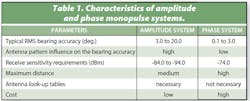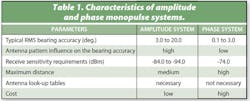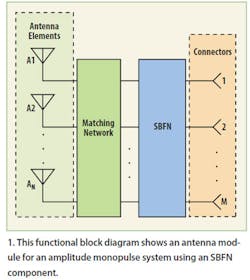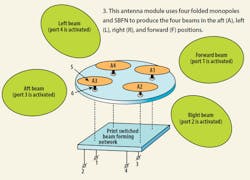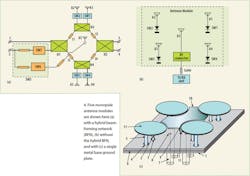Avionics systems designers constantly seek savings in size and weight through integration. The approach also lowers the number of cables needed and the power requirements. The use of integrated antenna modules is one approach that helps to achieve reductions in size, weight, and power usage in modern integrated avionics systems.1 Part 1 of this two-part article will review active antenna modules for avionics systems; next month, Part 2 will conclude with a specific antenna module solution.
As an example, the Traffic Collision and Avoidance System (TCAS) and Transponder system used on many aircraft employs four separate antennas, ten cables, and separate receivers and transmitters. With such a low level of integration, the system is costly, large, and heavy. In contrast, an integrated TCAS/Transponder system uses two combined antenna modules electrically connected to the single TCAS/Transponder transmit/receive unit.1-3 These modules must provide directional and omnidirectional operation. Directional operation supports the TCAS 1090 MHz, TCAS 1030 MHz transmit, and Transponder 1030 MHz receive functions. Omnidirectional operation is used for Transponder 1090 MHz transmit and sometimes TCAS 1030 MHz transmit functions.
For the integrated TCAS/Transponder system, L-band antenna monopole should satisfy the following performance requirements for the 1030-to-1090-MHz frequency band:
1. During directional operation, the antenna gain should be greater than 1.0 dB, the beamwidth greater than 90 deg., the sidelobe/backlobe level less than -8.0 dB, the gain variance from sector to sector less than 0.4 dB, the impedance matching a VSWR of less than 1.40:1, and the switching from directional to omnidirectional modes less than 1 s.
2. During omnidirectional operation, the antenna gain should be greater than -2.0 dB, gain ripples should be less than 2.0 dB, and impedance matching equivalent to a VSWR of less than 1.40:1.
For integrated systems that include TCAS functionality, such as TCAS/ Transponder systems, TCAS/Transponder/ Universal Access Transceiver (UAT) systems, TCAS/Transponder/ Distance-Measurement-Equipment (DME) systems, TCAS/Transponder/ Automatic Dependent Surveillance- Broadcast (ADS-B) systems,1 the combined antenna module must provide directional and omnidirectional modes, transmit and receive modes, and directionfinding (DF) functionality with acceptable bearing accuracy. The three main techniques used for airborne DF functionality are the amplitude- comparison method, the phase-comparison method, and the amplitude-phase method.4-6 The amplitude-comparison approach is relatively simple and cost effective but relatively inaccurate. The phase-comparison method, implemented by means of a phase interferometer, is more precise. The amplitude-phase approach6 is a compromise between the simplicity of the first approach and the accuracy of the second approach. Characteristics of airborne amplitude/phase monopulse systems are shown in Table 1.
This report will review different directional/omnidirectional antenna modules for the avionics integrated systems,1 including the TCAS amplitude monopulse system, which requires a directional antenna mode, and other systems such as Transponder, UAT, ADS-B, and DME systems that require an omnidirectional antenna mode. Figure 1 shows a functional block diagram of an antenna module for an amplitude monopulse system.
The switched beam-forming network (SBFN) can be constructed with a hybrid network, phase shifters, switches, dividers, etc. The directivity of the antenna is divided into N sectors horizontally. These sectors are sequentially scanned by the monopulse method. Usually, the antenna interface includes M (where M = N) coaxial connectors (Fig. 1) coupling the antenna module to the transmit/receive module through coaxial cables.
The amplitude monopulse architecture can include a four-monopole antenna with SBFN.1,3,7-10 A conventional TCAS directional antenna is a four-monopole, vertically polarized, monopole array that can transmit in four selectable directions at 1030 MHz. The antenna receives replies with bearing information from all directions simultaneously at 1090 MHz, using amplitude-ratio monopulse techniques. This antenna and interface require a complicated amplitude and/or phase calibration network.
The common TCAS/Transponder antenna module1 provides directional or omnidirectional (if necessary) TCAS radiation antenna patterns, omnidirectional Transponder radiation antenna patterns, and directional TCAS and Transponder receive antenna patterns. The TCAS electronics uses signals from the directional antenna to determine the bearing from the host system to another aircraft. The novel antenna module consists of the four-monopole antenna, SBFN, matching network, and interface.8,9
Each SBFN port is coupled through a cable to a corresponding receiver. An airborne amplitude monopulse system estimates an intruder aircraft's bearing by comparing magnitudes of signals received by the four-monopole directional antenna. The antenna aperture is divided into four sectors (or quadrants). The incoming signals are processed inside the antenna module to produce four electrical connector signals, such that each electrical signal represents a unique quadrant of the polar coordinate system. A significant bearing accuracy improvement can be achieved with the bearing algorithm (or index) using all four received signals in four sectors. In this case, the bearing may be detected not only by an antenna pattern main lobe(s) but by the sidelobe(s)/backlobe(s) of another beam(s). This additional information provides greater bearing accuracy and eliminates strong requirements for the sidelobe/backlobe level suppression.
The L-band antenna module provides the directional antenna patterns by using the special SBFN including the 4 x 4 hybrid matrix and switched 0/180-deg. phase shifter Fig. 2(a)>.8-10
The four 90-deg. hybrids are serially interconnected to form a 4 x 4 hybrid matrix. The four ports, 5, 6, 7, and 8, of the hybrid matrix are connected to the four antenna monopoles, A1, A2, A3, and A4, respectively, and the other four ports, 1, 2, 3, and 4, are connected to a transmit/receive network through cables. The eight-port hybrid matrix in the SBFN provides equal amplitudes and specific relative phases for the four antenna monopoles. The directional transmit mode is implemented by the alternative activation of one of the input ports, 1, 2, 3, or 4, of the SBFN while the switched phase shifter provides a 0-deg. phase shift. Each of the four antenna module inputs corresponds to a beam in one of four directions: front (F), right (R), aft (A), or left (L). During the receive directional mode, which provides a bearing measurement, all four of the antenna connectors are monitored.
The relative signal intensity from four SBFN ports 1, 2, 3, and 4 shows the azimuth direction of a selected object according to the special bearing algorithm (index) and antenna lookup tables (LUTs).11 Also, the TCAS/ Transponder antenna module should provide an omnidirectional transmit mode when the signal passes through only one SBFN input (2) while the switched phase shifter is in its 180- deg. phase shift state. In this case, the four antenna monopoles are activated with equal magnitudes and progressive 90-deg. phase shifts (0, 90, 180, and 270 deg.).8-10
The performance of different quadrature hybrids for possible antenna beam-forming-network (BFN) applications was considered in ref. 9. For broadband coupled-line hybrids Fig. 2(b)>, coupling tolerances are difficult to realize because of the narrow gap between the strips. The threebranch hybrid has a larger bandwidth than the two-branch hybrid but greater insertion loss and larger dimensions. Two-branch hybrids were used in the L-band BFN Fig. 2(a)>. These hybrids have low insertion loss, low phase error, and adjacent output ports that permit combining them in the planar BFN design.12 The disadvantage of the two-branch hybrid is its narrow frequency coverage, but for the required 10-percent bandwidth of a TCAS/Transponder system, its bandwidth is acceptable.
The SBFN includes the switched 0/180-deg phase shifter connected to one output of the hybrid matrix. To provide the amplitude balance (compensate phase shifter loss) at all four output ports, the BFN hybrids H1, H2, and H4 should have unequal power division10-12 and hybrid H3 should have equal power division. Therefore, the 4 x 4 matrix should be asymmetrical, taking into account the switched 0/180-deg. phase shifter loss, and providing equal magnitudes and specified phases at the four antenna monopoles. To realize the unequal power division, the hybrid impedances (or admittances) should be different from divider impedances (or admittances) with equal power division.
The straight connection of the four two-branch hybrids (without additional connection lines) makes the bandwidth of the 4 x 4 matrix slightly narrower than a single two-branch hybrid due to the undesirable interaction between the four hybrids. When the four hybrids are connected using quarter-wavelength transmission lines (inverters) the property of the circuit is improved. The four inverters, I1, I2, I3, and I4 Fig. 2(a)>, between the hybrids provide considerably widened bandwidth for improved insertion loss, isolation, and return loss of the 4 x 4 matrix. The hybrid matrix of the SBFN handles receive and transmit signals through the antenna monopoles and is configured to selectively switch between directional and omnidirectional operation.
Phase shifter
The antenna module Fig. 2(a)> provides directional and omnidirectional operations by using the switched-line 0/180-deg. phase shifter10,11 between antenna terminal 7 of the 4 x 4 matrix and the antenna monopole A3. The simple two-PIN-diode phase shifter was implemented in the antenna SBFN. The switched-line phase shifter Fig. 2(a)> uses two lines of different lengths: one is a "reference" line (L1), the other is a "delay" line (L2). Since only one of the two arms is selected, switches are required. PIN diode switches were chosen because high-power capability is the top priority. Unfortunately, a four-monopole antenna with a switched phase shifter suffers from limited bandwidth. Figure 2(b) shows a block diagram of the broadband antenna module3 without the narrowband switched phase shifter. During omnidirectional transmit mode (for Transponder, DME), the transmit signal passes from the integrated unit through the single-pole, double-throw (SPDT) switch and four-way divider to the four monopoles. The broadband divider can be implemented using conventional Wilkinson dividers or directional couplers. The four-way divider and the BFN are located close to the antenna monopoles to minimize phase and amplitude imbalance between the four terminals of the antenna module. During the TCAS directional transmit mode, the transmit signal passes from the integrated unit through the SPDT switch and the BFN to the four antenna monopoles. During the directional receive mode, which provides a bearing measurement, all four of the antenna terminals are monitored, and receive signals pass through the four SPDT switches and the BFN to the integrated transmit/receive unit.
Figure 3 shows an antenna module with four-folded monopoles.
The capacitive hat gives a uniform current distribution of the vertical feeding post and allows the antenna to be resonant with a reduced height and a wider bandwidth. The geometry of the top capacitive element allows a tradeoff between antenna size and bandwidth. This element stores charge so that more vertical current can flow than if the top disk were not present. Each of the four antenna module inputs corresponds to a beam in one of four directions: F, R, A, or L. Directional and omnidirectional antenna gains are related to monopole dimensions. The directional transmit mode is implemented by alternate activation of one of the SBFN's input ports 1, 2, 3, or 4. The position of the antenna pattern depends on which input is activated.
The five-monopole antenna module (Fig. 4) overcomes the limitation of the four-monopole antenna module.
It adopts both directional and omnidirectional modes without the switched 0/180-deg. phase shifter. During omnidirectional mode, the active center monopole (A5) is surrounded by four equidistant, symmetric parasitic elements (A1, A2, A3, and A4) on a circumference of radius r1, with r1 chosen to optimize directional and omnidirectional characteristics. The parasitic elements are shorted to ground by single- pole single-throw (SPST) switches SW1, SW2, SW3, and SW4 Fig. 4(a)>. Parasitic posts lead to higher gain and better omnidirectional patterns.11
Antenna elements and antenna inputs are switched using PIN diodes. By controlling PIN diode states (on or off), different sets of short-circuited monopole function as directors or reflectors. The active center element is electrically connected to transmitter/receiver through SPDT switch SW5. During the omnidirectional mode, the antenna matching is mainly controlled by the diameter of center monopole A5. Under directional operation, the array is electronically switched to each of the four positions sequentially by the alternating activation of the four antenna module terminals 1, 2, 3, or 4 Fig. 4(a)>. During the directional mode, all four outside active monopoles (A1, A2, A3, and A4) are electrically connected to the BFN antenna terminals while the center parasitic monopole (A5) is shorted by SPST switch SW6.
Figure 4(b) illustrates the fivemonopole directional/omnidirectional parasitic antenna without the hybrid BFN. This antenna consists of one active center monopole (A5) connected to the transmitter and four parasitic elements (A1, A2, A3, and A4) in a circle. The parasitic elements are switched using PIN diodes connected to the ground plane. By switching, different sets of parasitic elements function as directors and reflectors around the active center monopole.13,14
Usually, the parasitic elements become reflectors when shorted to ground plane. The parasitic elements become directors when opened. During the omnidirectional transmit mode the active center monopole (A5) is surrounded by four equidistant, symmetric parasitic elements (A1, A2, A3, and A4). The switch circuits of all parasitic elements are switched off. Since the parasitic elements act as directors, the omnidirectional mode is realized. During the directional mode, different combinations of switched elements (SW1, SW2, SW3, and SW4) support different radiation patterns.
For a directional beam, three of the four parasitic elements are shorted to ground with the forth floating. The directional pattern can be steered by alternating open elements. Via electronic control, the main beam can be switched to one of four directions.
The directional information can be obtained to sample the received signal with several different radiation patterns, since the switching time of a PIN diode is only of the order of a few nanoseconds.13 The DF performance of this antenna is sufficient and the cost reduction of a single receiver compared to traditional antenna arrays outweighs the loss in performance for broad-side angles.
Figure 4(c) shows a sketch of a five-folded-monopole antenna with a single metal base ground plate (base plate, 1), four feeding posts (2), four shorting posts (3) (which can also be implemented as part of the ground plate), four capacitive hats (11), one center feeding post (9) with capacitive hat (10), an SBFN multilayer card assembly (6), and four electrical connectors (7). The shorting post provides a reduction in physical size. The electrical characteristics of the folded monopole antenna depend on the height and size of the capacitive hat, the groundplane dimensions, the diameters of the feeding and shorting posts, and the spacing between them. The vertically polarized antenna is designed for the 1-GHz band. The antenna dimensions have been optimized to achieve a low profile and for good gain and matching for both directional and omnidirectional modes. The heights of the feeding posts and shorting posts are equal to 0.043?. Each capacitive hat area is equal to 0.027?. The four feeding posts (2) and the center post (9) are electrically coupled to the four capacitive hats (11) and the center capacitive hat (10), respectively, on one side, and to the antenna terminals of the SBFN on the other side. The space between the diagonal feeding posts (2) is 0.25?. Each shorting post (3) is electrically coupled to one of the capacitive hats (11) on the one side and to ground plate (1) on the other side.
Next month, this two-part article will conclude with an exploration of an active antenna module for TCAS applications.
REFERENCES
1. L. G. Maloratsky, "RF Design of Avionics L-Band Integrated Systems," Microwave Journal, 2009.
2. D. Kutman et al., "Multifunctional Aircraft Transponder," US Patent No. 6,222,480, April 2001.
3. L. G. Maloratsky et al., "Combined Aircraft TCAS/Transponder with Common Antenna System," US Patent No. 7,436,350, October 2008.
4. "Signal Sorting Methods and Directional Finding," www.microwaves101.com/enciclopedia/.
5. "An Introduction to Dipole Adcock Fixed-Site DF Antennas," Application Note AN-005, PDF Products, December 1999.
6. M. F. Gard, M. F., et al., "Electronic Compass," US Patent No. 5,850,624, December 1998.
7. B. E. Dinsmore et al., "Apparatus and Method for an Amplitude Monopulse Directional Antenna," US Patent No. 5,191,349, March 1993.
8. L. G. Maloratsky et al., "Aircraft Directional/Omnidirectional Antenna Arrangement," US Patent No. 7,385,560, June 2008.
9. L. G. Maloratsky, "Switched Directional/Omnidirectional Antenna Module for Amplitude Monopulse Systems," Antenna Magazine IEEE, October 2009.
10. L. G. Maloratsky et al., "Switched Beam Forming Network for an Amplitude Monopulse Directional and Omnidirectional Antenna," US Patent No. 7,508,343, March 2009.
11. L. G. Maloratsky, "Analyze Bearing Accuracy of a Monopulse System,"Microwaves & RF, Part 1, March 2009, Part 2, April 2009.
12. L. G. Maloratsky, Passive RF & Microwave Integrated Circuits, Elsevier, 2004.
13. T. Seki, "Low-loss and Compact Sector Antenna that Adopts Omni-directional Characteristics," 2000 IEEE Antenna and Propagation Society Int. Symposium, Vol. 2.
